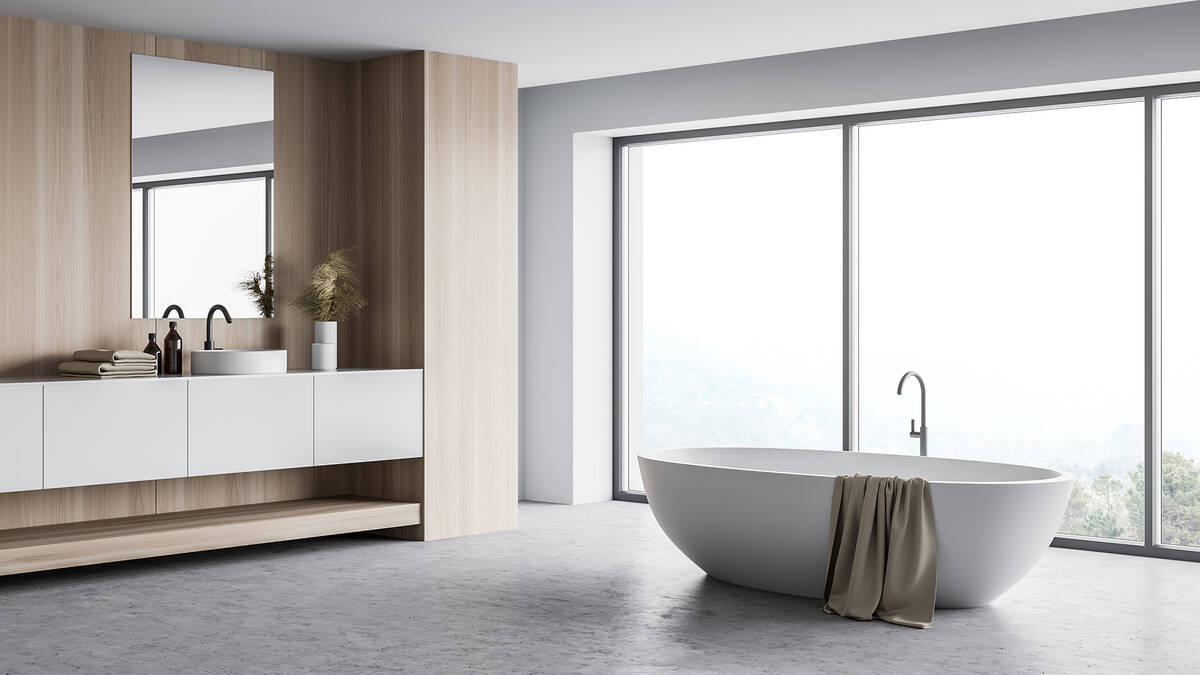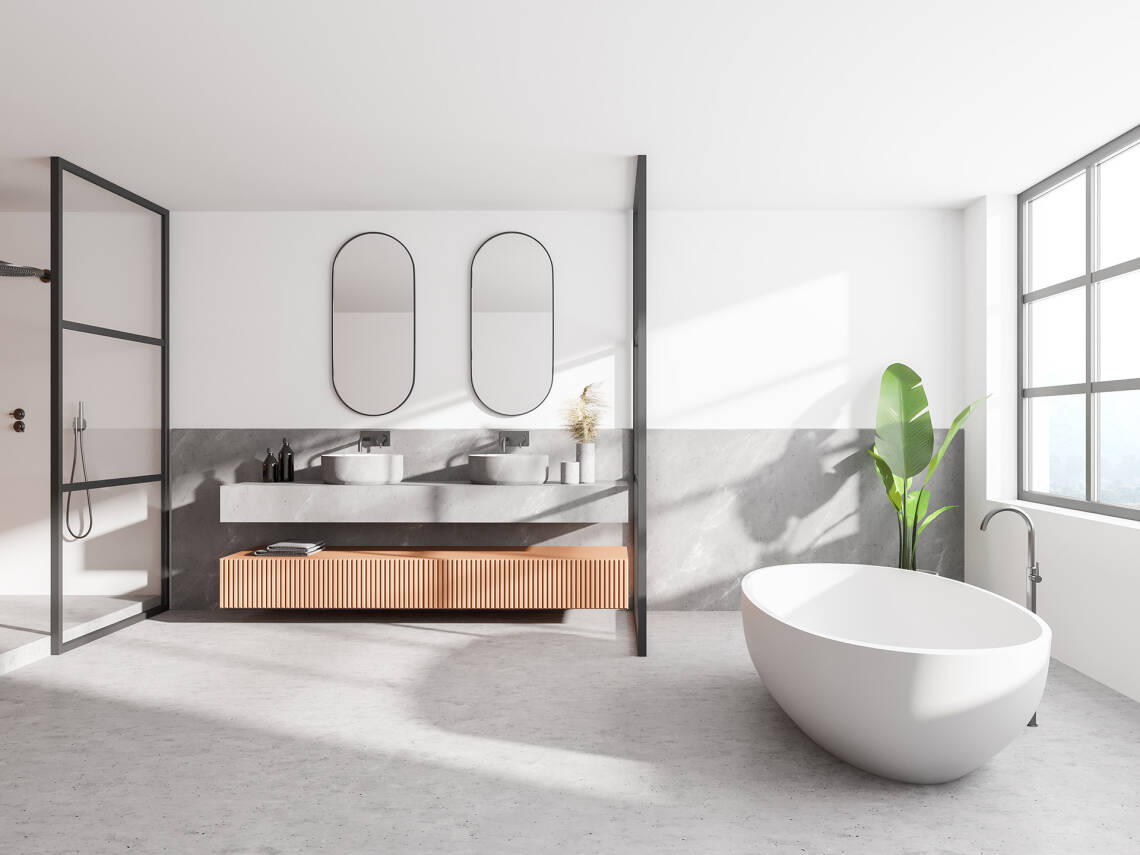Many advantages to doing without grout
Grout-free bathroom – stylish trend with practical benefits
Doing without tiles and grout in the bathroom is becoming increasingly popular. But what are the advantages of a bathroom without tiles? What are the advantages and disadvantages of different materials? Learn here which building materials are suitable for floor and wall cladding and get answers to common questions.

Elegant solutions with optical depth of field

A seamless bathroom has several practical advantages. The large surfaces of the walls and floor automatically appear spacious and lavish without the interruption of grout or joints. The eye perceives the entire dimension and doesn't get lost in small-scale tiles. Rooms with limited space will especially benefit from the visual expanse created in this way.
This departure from the classic bathroom look also leads to improved hygiene, as impurities can settle in the joints between the tiles. The high humidity in this room quickly creates a biofilm – the perfect foundation for mold growth.
However, the use of grout-free materials requires professional expertise. For that reason, you should expect a slightly higher cost.
Classic and modern materials instead of traditional tiles
There are a wide variety of materials to choose from when designing a grout-free bathroom.
We’ll present the following materials in detail here:
- Wood
- Decorative panels
- Beton ciré
- Lime plaster
- Wallpaper
- Synthetic resin
- Wood: Warm and robust
Wood is a sustainable material with a particularly homey effect. For the bathroom, choose a type of wood that absorbs little moisture. Oak, walnut, Douglas fir, teak, and merbau are perfect choices. However, a classic parquet floor or wooden wall paneling requires a little more care in damp spaces. Instead of varnish, we recommend finishing the surface with oil, as sealed wood can crack when left in standing water.
Decorative panels: For every taste
Large-format decorative panels are available in a variety of designs. Glass or acrylic glass will achieve a color-intensive depth effect, as a motif is applied to the back and shines through the glass. Decorative panels made of aluminum are very robust and scratch-resistant. Composite aluminum with printed surface is almost indistinguishable from natural material. Some manufacturers will let you print your photo motifs on the panels. Decorative ceramic tiles are also available in numerous colors, shapes, and designs. The usual seams and grout of tiles are eliminated. However, there may be material joints between individual panels.
Beton ciré for minimalist elegance
Beton ciré, a fine-grained mineral mortar, creates a fine concrete look on walls and floors. Beton ciré translates as “polished concrete.” For this, white or gray cement is mixed with synthetic resin, quartz sand, and various fillers. It provides a seamless surface in a wide variety of colors. The material can also be applied to existing tiles, as it forms a surface only a few millimeters thick. Beton ciré insulates noise, is water-repellent, and heat-insulating.
Lime plaster: An ecological classic
Lime plaster is an ecological classic, ideal for damp spaces. This purely mineral material hardens without additives and has been used since ancient times. Lime plaster can be colored as desired. It can absorb and release moisture. Moreover, it counteracts the formation of mold. The tadelakt technique, which originated in Morocco, seals the surface and makes it water-resistant. The lime plaster is compacted with a polishing stone and then made hydrophobic with a soap made from olive oil, so water can roll off.
Wallpaper for versatile looks
Damp-proof wallpapers based on non-woven or fiberglass are available in an infinite variety of patterns and colors. The wallpaper can easily withstand moisture and water vapor. However, they are less suitable for the splash area above the sink or directly next to the shower. They should be fixed with a wallpaper adhesive suitable for damp spaces.
Durable, synthetic resin
This synthetic material can easily stand up to moisture and doesn’t require care or maintenance. You can have synthetic resin colored in any shade. When renovating a bathroom, you can simply use it to cover existing tiles. It can even waterproof bathroom furniture. Processing is demanding and should only be carried out by certified professionals.
Frequently asked questions about the grout-free, tile-free bathroom
It makes the space look larger and improves hygiene, as seams are prone to mold.
Choose a suitable wood species like oak, walnut, red fir, teak, or merbau. Also, the surface should be oiled.
Beton ciré, or ‘polished concrete,’ is concrete made of white or gray cement mixed with synthetic resin, silica sand, and various fillers, and can be colored as desired.
Use the tadelakt technique: it involves compacting the surface with a polishing stone and then proofing it with soap.
Non-woven or fiberglass wallpapers can withstand high humidity, but are not suitable for the splash area around the sink or shower.
Seamless freedom in the bathroom – with the right material
There are solid reasons behind the trend towards bathrooms without tiles: Seamless wall coverings look spacious and improve hygiene, as joints are the perfect breeding ground for mold. A wide variety of materials are suitable for a grout-free bathroom: in addition to beton ciré and decorative panels, you can also work with wood, wallpaper, lime plaster, and synthetic resin.
Trusted partners